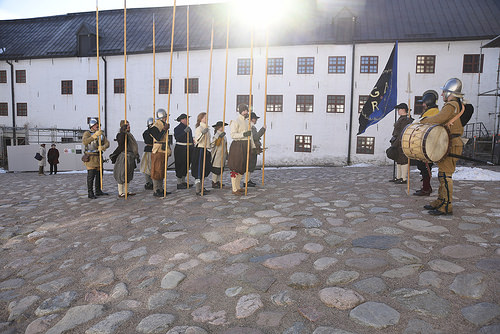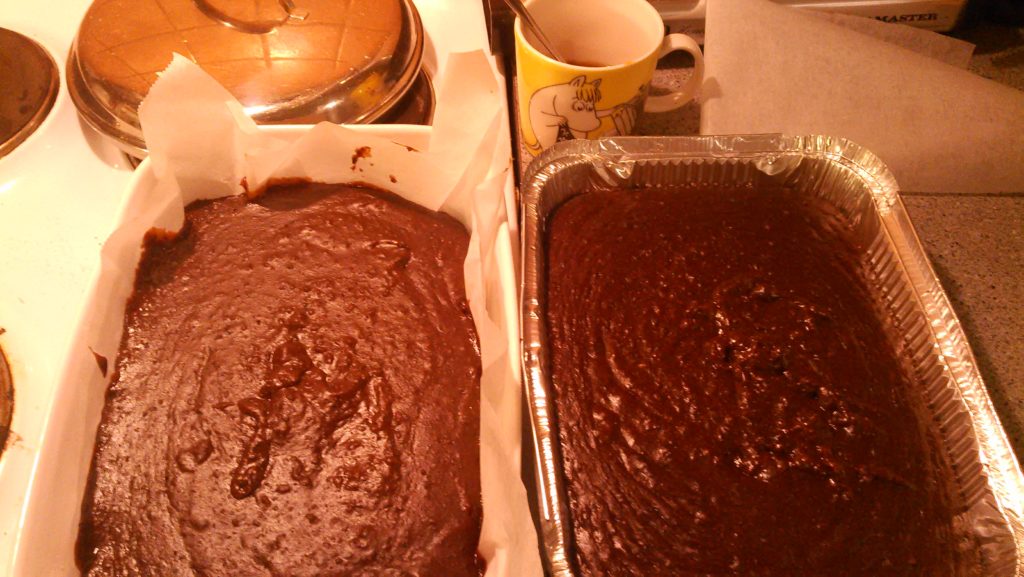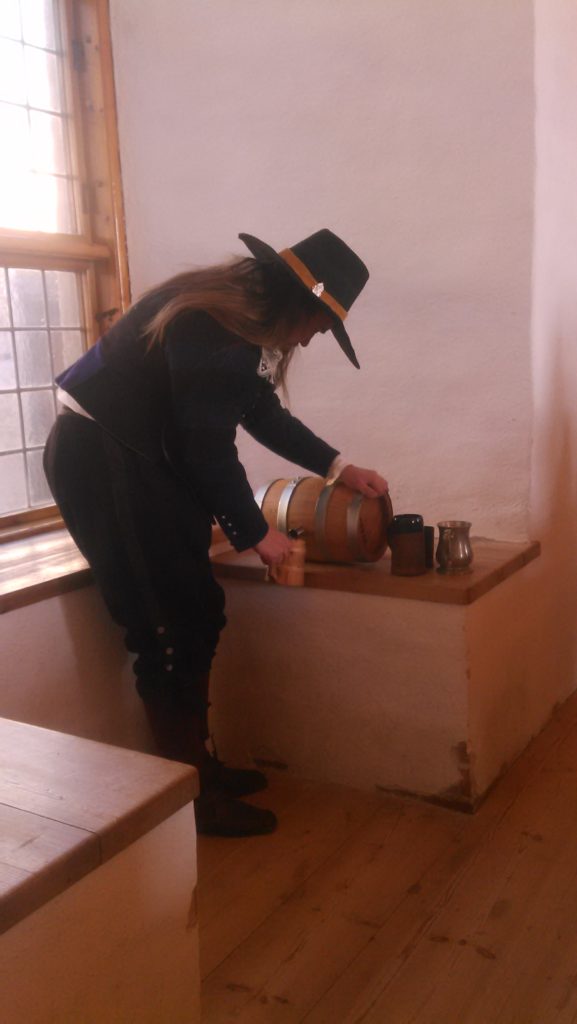GARS kävi esiintymässä Turun linnalla maaliskuun ensimmäisenä sunnuntaina. Pikenööripäivään sisältyi kaksi äkseerausnäytöstä linnan pihalla, tutustuminen linnaan ja erityisesti Valtapeliä – Reformaatio Suomessa -näyttelyyn, sekä kylmä lounas 1600-luvun sotilashengessä.
On the first sunday of March, GARS made a trip to Turku Castle. We had two pike drill shows, visited the castle and especially their exhibition on reformation in Finland, and had a cold lunch in 17th century military style.
Noin tunnin äksiisin jälkeen nälkä alkoi olla jo aikamoinen. Nautimme lounaan linnan renessanssisalissa lähes autenttisessa 1600-luvun ympäristössä. Tosin sotilaat eivät olisi näin hienoihin tiloihin päässeet, vaan ruoka olisi tarjoiltu linnantuvassa.
After one hour drill we started to get hungry. We had our lunch in the renaissance hall of the castle in an authentic 17th century surroundings. Although back then, soldiers would have eaten in the common dining hall.

Keihäät kulkevat hyvin myös kapeassa portaikossa / Pikemen can go also in narrow staircases (c) GARS 2017
Koska käytössämme ei ollut keittiötä, valmistimme ruoat etukäteen. Tarjolla oli perinteisen ruisleivän, juuston, lihan, kananmunien ja kalapiirakan lisäksi länsisuomalaista erikoisuutta, mämmiä. Mämmi tunnetaan jo katolisen ajan paasto- ja eväsruokana, ja myöhemmin siitä tuli suosittu pitoruoka. Mämmiä syödään nykyisinkin koko Suomessa pääsiäisen tienoilla, joten katolisesta tavasta ei suinkaan ole kyse!
We didn’t have kitchen, so lunch was prepared beforehand. We had rye bread, cheese, ham, boiled eggs, salmon pie, and local Western Finland speciality, mämmi. There are mentions of mämmi in the Middle Ages during Lent and as food for travel, and later it became a festive dish. Mämmi is still popular in Finland during Easter holidays, so it’s in no way a catholic tradition!
Mämmi valmistetaan ohramaltaista ja ruisjauhoista imeltämällä. Imeltämisessä maltaiden ja rukiin tärkkelys pilkkoutuu sokeriksi. Tärkeintä prosessissa on lämpötilan pitäminen tasaisena, jotta imeltyminen onnistuu. Sokeri on ollut harvinainen yläluokan herkku aina 1800-luvulle asti, ja jos hunajaankaan ei ollut varaa, oli imeltäminen ainoa keino valmistaa makeita ruokia. Ohje on sovellettu Marttojen ohjeesta.
Mämmi is made from malt and rye flour by a special technique called imeltäminen. It’s what happens when starches in malt and rye are modified into sugar in certain warm temperatures. It is important to keep the temperature steady for the whole process. Imeltäminen creates a sweet taste, which was hard to achieve before sugar came into wider use in the 19th century. Honey was also expensive, so imeltäminen was the only way to make sweet dishes.
Mämmi 1600-luvun tapaan / Mämmi in 17th century style
1. vaihe / stage
1 l vettä / water
200 g mämmi- tai kaljamaltaita / malt
400 g ruisjauhoja / rye flour
2. vaihe / stage
1,5 l vettä / water
150 g mämmi- tai kaljamaltaita / malt
300 g ruisjauhoja / rye flour
1. vaihe. Kuumenna vesi poreilevaksi (n. 70 astetta) isossa kattilassa. Sekoita veteen maltaat ja ruisjauhot. Ripottele pinnalle hieman ruisjauhoja. Peitä kattila kannella. Anna imeltyä 1½-2 tuntia lämpimässä paikassa, esimerkiksi uunissa 50 asteen lämmössä. Imeltyminen tapahtuu 50-75 asteessa, joten lämpötilaa ei saa ylittää eikä alittaa. Onnistunut imeltyminen tekee seoksesta juoksevampaa.
1. stage. Warm the water to ca. 70 degrees Celsius in a large kettle. Add malt and rye flour and mix together. Sprinkle some flour on top and cover the kettle with a lid. Put the kettle to an oven in ca. 50 C for 1½-2 hours. The modification of starch into sugar happens in 50-75 C, so that should be the temperature for the whole process. If imeltäminen is done correctly, the mix should be a bit more runny than when it was put to the oven.
2. vaihe. Kuumenna vesi poreilevaksi ja lisää kattilaan. Sekoita joukkoon maltaat ja jauhot. Jatka kuten edellä ja anna imeltyä taas pari tuntia lämpimässä uunissa.
2. stage. Warm the water to 70 C and add to the kettle. Add more malt and flour to the mix and let it stay in the oven as in stage 1 for a couple of more hours.
3. Tässä vaiheessa mämmin tulee olla löysän puuron vahvuista. Lisää tarvittaessa jauhoja. Keitä seosta 10 minuuttia koko ajan hämmentäen varoen pohjaan palamista. Jaa mämmi tuokkosiin, leivinpaperilla vuorattuun uunivuokaan tai foliovuokiin. Jätä kuohumisvaraa noin 1/3 vuoan korkeudesta. Astian on hyvä olla laakea, ja mämmiä noin 5 cm paksuinen kerros, jotta nestettä haihtuu riittävästi.
3. Now the mix should resemble thin porridge. Add flour if it’s too runny. Boil for 10 minutes, stirr constantly and be careful that the mix doesn’t burn. Pour it into traditional bowls made of birch bark, disposable folio dishes or oven dishes covered with baking paper. Fill the dishes 2/3 full. Mämmi should not be more than 5 cm thick, so the moist evaporates more effectively.
4. Paista uunin alatasossa 170 asteen lämmössä 2½-3 tuntia. Mämmi on parhaimmillaan muutaman päivän kuluttua. Tarjoa kylmänä.
4. Bake in 170 C for 2½-3 hours. Mämmi is best after a couple of days in the fridge. Serve cold.
Nykyään mämmi syödään useimmin kerman ja sokerin kera. Kermaa ei kuitenkaan olisi ollut 1600-luvulla tarjolla tähän aikaan vuodesta, koska lehmät olivat talven ja kevään ummessa. Lypsy onnistui vain kesäisin ja syksyisin, kun lehmillä oli tuoretta ruokaa. Lisäksi suurin osa kermasta käytettiin voin valmistamiseen, eikä ruoanlaittoon. Ja kuten mainittu, sokeria ei ollut aikakautena yleisesti saatavilla.
Nowadays mämmi is usually eaten with cream and sugar. But in the 17th century there would not have been cream available during winter and spring, only in summer and autumn, when there would be fresh food for cows. Most of the cream was also used to make butter, not in cooking. And as mentioned before, sugar was not widely available in the early modern period.
Kuvia tapahtumasta / More pictures here: https://www.flickr.com/photos/128865949@N07/sets/72157677587267174
https://henluo.kuvat.fi/kuvat/Turun+Linna+5.3.2017/
Jenni






